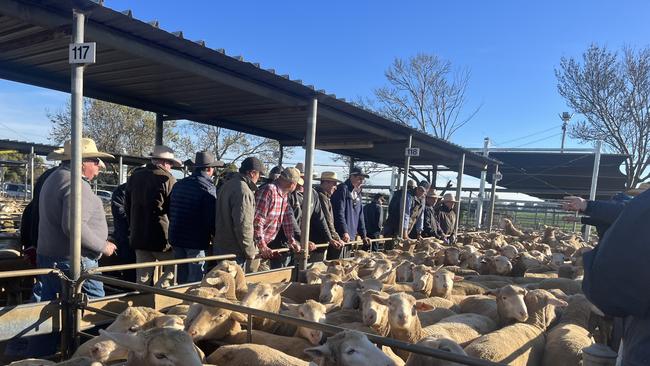Lamb prices hit 1000c/kg as producers reap rewards
Lamb prices have broken through 1000c/kg but how much longer will it last? We ask the experts how they see the market playing out.
Stellar prices of up to 1000c/kg for heavy lambs are creating a ripple effect across the whole market in a boon for the sheep industry.
And while the stunning rates are only being paid to a portion of producers, they are injecting much needed confidence after last year’s tough trading environment.
Some of the impressive results have included:
EXPORT lambs making up to 1000c/kg carcass weight and averaging 963c/kg at Wagga Wagga last week;
HEAVY lamb prices gaining 67c/kg in the past month and running 39 per cent higher than a year ago;
RESTOCKER lamb prices jumping from 561c/kg at the start of spring to 734c/kg this week, and
NATIONAL and heavy lamb indicators 39-41 per cent above the same time last year.
But some analysts are warning the heady prices may be only weeks away from coming off as those lambs that have been turned out come back into the offerings.

Wagga Wagga’s market last week set the tone with 30,000 lambs making up to $285 where prices “exhibited no boundaries” according to the National Livestock Reporting Service report.
Nutrien Wagga Wagga agent Hamish McGeoch said the prices were surprising.
“It was a very good day (at the Wagga Wagga sale) if you had your lambs right,” Mr McGeoch said.
“A lot of lambs were making more than 900c/kg.”
Mr McGeoch said restockers were consistently paying between $100-$150 for lambs to put back in the paddock.
And the price lifts continued early this week at southern markets at Bendigo, Hamilton and across the border at Corowa, NSW, where the combined saleyards offering of more than 60,000 lambs saw prices for the best lambs nearing 1000c/kg carcass weight at all sales.
Paull and Scollard Nutrien Corowa branch manager Richard Wynne said he did not think the big prices would last too long.
“I think in six (working) weeks’ time, we won’t be seeing these prices because there are a lot of lambs going to restockers that are going to come back in,” Mr Wynne said.
But he said those who had been brave enough to feed lambs, despite the tight season in the area, were being rewarded with 970-980c/kg carcass weight seen for the best lines at Corowa on Monday.
“I had a client who wanted to sell all his lambs earlier as suckers and we decided to hold some back and sell as shorn lambs, and they averaged $254 today,” Mr Wynne said.
“We are seeing processors who can’t buy export lambs push back into buying trade lambs, and then even the tops of the store lambs if they need numbers.”

Meat and Livestock Australia market information manager Stephen Bignell said there was only one other time when December rates had reached this level: in 2021, when the flock was in a rebuild phase post-drought.
The headline-grabbing prices of up to 1000c/kg carcass weight were for heavy export lambs, he said, and there fewer about than normal.
But Mr Bignell said other lamb prices were being dragged up with them as processors looked to find stock for their kill chains, and producers bought restocking lambs on the back of greater confidence in the industry.
“We usually see peaks in lamb prices in March, and then July/August, so to see the highest prices paid for lambs this year in December is uncommon,” Mr Bignell said.
Mecardo market insights analyst Olivia Agar said the highest prices were for “pretty limited numbers of prime stock”.
“Heavy lamb prices in December 2021 came close to the levels we are currently seeing, but it looks like the opening week of December finished lamb market was as strong as its ever been,” Ms Agar said.
“There’s no doubt that finished lamb supply for this point in the season is much tighter than we’ve seen in a long time.
“We have to go back to 2005 to find a year when rainfall through southern Victoria and south east South Australia was similarly ‘very much below average’ from April to July, which has really restricted the ability to put weight on lambs.”

She also warned that the rally may be short lived.
“More lambs have gone back to the paddock this year than last and MLA’s Sheep Producer Intentions survey suggests that producers intend to sell 46 per cent of expected lamb sales in the new year,” Ms Agar said.
“Forward pricing into January is giving some security on the price levels, but come February we are likely to see some supply pressure creep back in.”
Ms Agar said the weak Australian dollar was helping with the affordability of Australian lamb in the export market.
“Looking at heavy lamb prices in $US terms, there have been quite a few periods over the past five years where lambs were bought at these levels or even briefly higher,” Ms Agar said.
“We may start to see a bit of resistance by processors now at these levels but it’s certainly promising that the market has remained so strong through spring, and that the overseas demand has been there at elevated prices.”
Despite the challenging year in many key production areas, Australia has already set new highs for lamb and mutton exports for the calendar year with a month of volumes still to go.
From January to November, 331,037 tonnes of lamb and 229,213 tonnes of mutton have left Australian shores, with the United States dominating lamb and China mutton.




